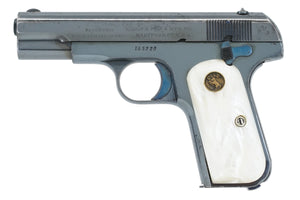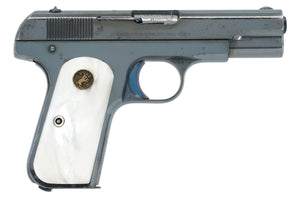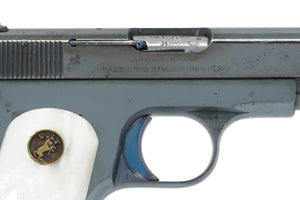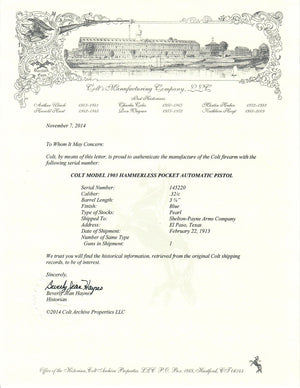OLD COLT: WE PROVIDE THE PUBLIC WITH AN ONLINE EDUCATIONAL RESOURCE FOR OLD COLT GUNS.
OLD COLT: WE PROVIDE THE PUBLIC WITH AN ONLINE EDUCATIONAL RESOURCE FOR OLD COLT GUNS.




This Colt 1903 Pocket Hammerless shipped to the Shelton-Payne Arms Company in El Paso, Texas on February 22nd, 1913 in a single gun shipment. The letter states this gun shipped with a blue finish and pearl grips. What is not usual is that this pistol has german proof marks on the right side of the slide and the frame.
The question becomes, how does a gun shipped to Texas in 1913 come to have 1940’s German proofs on it?
The fact that 1913 was right in the middle of the Mexican Border War seems a fairly obvious place to begin. It does, however, require a degree of reasonable assumption to follow the trail to its conclusion. First off, the fact that the Shelton Payne Company is known to have specialized in exporting guns into Mexico provides the most likely explanation as to how the gun would have wound up in Germany the early 1940’s.
History has shown that during the Border War period the Germans had been encouraging the Mexicans to recapture the Southern regions of the US. Which had once belonged to Mexico. Apparently, Germany’s tactical strategy was to keep the American Army engaged on our Southern border so we would be less likely to enter the European war in support of the British and the French. Germany was not only supporting the various Mexican factions financially during this period, they also sent a group of highly sophisticated advisers and even sent some regular fighting troops, some of whom were actually killed in border skirmishes.
Eventually, an important communication between the German and Mexican Governments was intercepted, inciting the Mexicans to invade and promising them they could keep any and all land they could capture from the United States. The discovery of this document, known as the Zimmerman Memo, was the final straw which convinced then President Woodrow Wilson to seek congressional approval for a declaration of war against Germany.
This border war situation then, provides the most likely connection between Mexico and Germany. The individual who originally owned a fancy pocket pistol like this was probably not riding around on a horse with the Banditos. He was much more likely a suit and tie type involved in the supplying of firearms to the Mexicans. Then, after the conflict was over and WWI had ended, he probably brought the gun back to Germany with him on his return voyage, as there were no restrictions on carrying guns aboard ship in those days. After that, there is no record of the gun until 1940 when it was proofed for resale and apparently sold to another highbrow type involved with the German war effort in WWII.
This last part is the most speculative, but it is logically supported by the condition of the gun and it's lack of German export marks. It is not likely that it had been carried by anyone in a combat intensive assignment for several reasons: One, the type of gun and the availability of replacement ammunition; two, the fact that it would have been a private purchase rather than a government issue side arm; and three, it would have been impossible for anyone to have taken such good care of the gun under the front line combat conditions of WWII.
Finally, it would have undoubtedly been a captured piece brought home as a war souvenir by a returning American serviceman. Otherwise, it would have required German export marks which are conspicuously absent and which could not have been removed without mining the finish. Again, the surviving condition of the piece suggests that it was most likely captured from someone fairly sophisticated who carried it during the war, possibly a pilot or someone in the German Secret Service who would have worn civilian clothes. It is equally likely to have been brought home by someone capable of appreciating the beauty and delicacy of the finish, probably an officer, who apparently continued to take very good care of this wonderful specimen from the end of WWII until very recently.
So, there you have it. A really special piece gets sold through a prominent Texas dealer, gets exported into Mexico, serves on the Mexican side of the Border War, goes half way around the world to Germany, then gets recaptured at some point in WWII and returns home to its birthplace here in America. All while managing to remain in remarkably good condition.